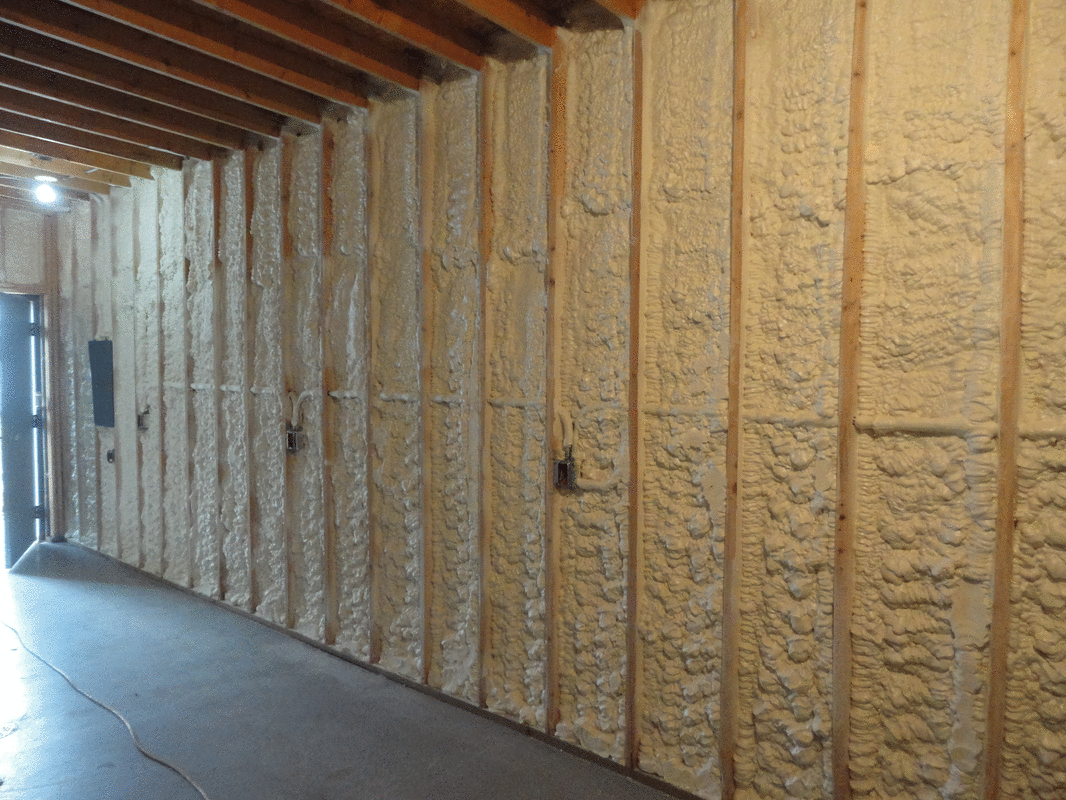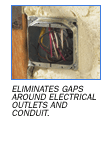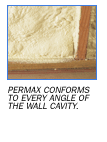Spray Foam Insulation
J. Myers Builders, Inc. has been installing spray foam insulation in New Hampshire and Vermont since 2002. We install both closed cell spray foam and open cell spray foam. We insulate larger commercial buildings, new homes, and small home renovations.
A good insulating system includes products and construction techniques that protect a home from outside hot or cold temperatures, protect it against air leaks, and control moisture. You can increase the comfort of your home while reducing your heating and cooling needs by investing in proper insulation and sealing air leaks. Spray foam insulation has the highest R-value per inch of any insulation and creates a barrier that stops the movement of air and water vapor.
Spray foam qualifies for Federal tax credits. Click HERE for more information.





Scroll through the images to see examples of spray foam.
What is spray foam?
Spray polyurethane foam is a spray-applied insulating foam plastic that is installed as a liquid and then expands many times its original size. It is made by mixing and reacting unique liquid components at the job site to create foam. Polyurethane foam is sprayed directly onto wall and floor cavities as a liquid and quickly transforms into thick, hard foam insulation. There are two categories of foam: half-pound open cell foam and higher density two-pound closed cell foam, which acts as a unique air and moisture barrier in one. Scroll down for more information on open cell and closed cell foam.
Where can spray foam be installed?
Spray foam adheres to just about everything so it can be installed over concrete, stone, wood, steel, and most existing roof systems which saves on the expense of roof removal and landfill fees. Spray foam can also be spray applied to tapered roof systems, which eliminates the need for costly tapered insulation systems.
Fire Protection
To adhere to local building codes, DC 315 Thermal Ignition Barrier is painted over spray foam. DC 315 is a water based coating specifically designed to be applied over polyurethane spray foam. DC 315 dries quickly and prevents the start and spread of flame on the surface of the spray foam. DC 315 complies with ICC-ES AC 377 Appendix X (Modified NFPA 286) concerning fire protection and spray foam insulation. Click HERE to find more information on DC 315 Thermal Ignition Barrier.
What are the benefits of spray foam?
Thermal insulation and draft reduction
Insulation, working together with the roof, wall and foundation assemblies, forms the building envelope. The building envelope functions to keep wind and unconditioned air out of the building, keep warm (or cool) air in, and prevent drafts. Movement of air into and out of the home can have many detrimental effects, including heat loss, moisture infiltrations, and the introduction of airborne pollutants.
Air moves into and out of your home around every crack, hole and seam. Even small voids in irregular framing or at the end of the batt of 1% of the insulation area can result in a 25-40% loss of R-value. A typical 2,500 sq. ft. home has more than 1⁄2 mile of cracks and crevices. These occur in plumbing and electrical outlets, gaps in drywall and exposed wall plates, and around framing joists.
Spray foam acts as an insulation and an air barrier in one product. Spray foam can be used to fill gaps and stop the leaks in many areas of a home or building.
Closed-cell foam is the highest-R-value insulation material available, at up to R6 per inch (the higher the R value of a material, the greater its resistance to the movement of heat).
Spray foam roofs also reduce thermal shorts or bridges. Traditional roofing materials must be nailed down or fastened to the roof deck with metal fastenings, creating a thermal short or bridge from the conditioned building interior to the outside roof deck. Spray foam roofing does not require metal fastening since the foam bonds directly to the roof deck in a continuous layer of insulation.


Home after air leaks have been sealed with spray foam
Click on the image to enlarge.
Click on the image to enlarge.




Energy Savings
As much as 40% of a building's energy is lost due to air infiltration. Gaps, holes and air leaks—which can all be prevented—can make energy bills unnecessarily high and let valuable resources go to waste.
Spray foam offers a solution: it performs as both insulation and an air sealant, or air barrier, closing those nooks and crannies that let air escape and add dollars to monthly energy bills. The U.S. Environmental Protection Agency's (EPA) Energy Star program estimates that by adding insulation and sealing air leaks, you could save up to 20% on your monthly energy bills.
The U.S. Department of Energy estimates that 56% of the energy used in a home goes to heating and cooling. Your home's heating, ventilating, and air conditioning (HVAC) system has a big effect on your utility bills and your energy consumption. Maintaining an optimal HVAC system can make your home more energy efficient. Spray foam insulation can help reduce the workload on your HVAC system thanks to its high R-value and effectiveness. In fact, with spray foam, HVAC sizing can be reduced as much as 35% without the loss of efficiency and comfort.
Moisture Control and Indoor Air Quality
Spray foam can improve the indoor environment, which makes your home or building more comfortable in many ways. Sealing a building's air leaks prevents drafts from windows, doors, attics and floor boards, creating a more comfortable indoor environment and providing better indoor temperature control. Especially in areas with extreme climates, good indoor temperature control can have a dramatic effect on household comfort.
Using spray foam to seal gaps and air leaks can help manage moisture and humidity in a building. By controlling moisture, spray foam can limit one of the key variables that can lead to mold and mildew growth. Spray foam prevents moisture and condensation throughout the building envelope, thereby helping to prevent the growth of mold and mildew.
Sealing gaps with spray foam can provide a barrier against pollen, dust and insects. Reducing the entrance of external allergens can be especially helpful in households with allergy sufferers.
Structural Strength
Applying closed-cell spray foam in the cavities of the walls increases durability of the wall system because of the foam’s ability to mold and adhere to the surface upon which it is sprayed. In fact, a wall with spray foam insulation has a higher racking strength, or ability to maintain its shape under duress, than a wall assembly without spray foam.


Closed Cell Spray Foam
Closed cell foam differs from open cell foam in that all of its tiny foam cells are closed and packed together. They are filled with a gas that helps the foam rise and expand and become a greater insulator. Closed cell foam for insulation applications range in density from 1.7 lb./cu. ft. to 2.0 lb./cu. ft. The higher the density the foam, the heavier, or stronger it becomes. J. Myers Builders, Inc. installs all types of foam ranging from 0.5 lb./cu. ft to 2.5 lb./cu. ft. Our standard foam is PERMAX 1.8 lb./cu. ft closed cell spray foam. PERMAX 1.8 is a 2-component polyurethane spray foam system consisting of Components A and B, which when sprayed through special plural component spray equipment, will produce a premium seamless, monolithic, and durable closed-cell polyurethane foam air barrier/insulation/vapor retarder suitable for residential and commercial wall applications. We install other brands of spray foam upon request.
You can download technical specifications and MSDS information for PERMAX spray foam HERE.
Closed cell spray foam creates an air and vapor barrier and does not absorb moisture. This can be an advantage in basements where the insulation may come into contact with moisture. Closed cell foam dries rigid, creating structural stability and impact resistance. Closed cell foam has a great thermal insulation value - R 6.0 per inch thickness. Closed-cell foam would be a good choice where small framing sizes need the greatest R-value per inch possible. Closed-cell foam would be used for roofing applications, on stone foundations, or in a traditional framed wall.


Open Cell Spray Foam
Open cell spray foam differs from closed cell foam in that the tiny cells of the foam are not completely closed. They are broken and air fills all of the “open” space inside the material. This makes the foam softer feeling than closed-cell foam. Open cell foams typically weigh in at 0.4 to 0.5 lb./cu. ft. J. Myers Builders, Inc. installs PERMAX 0.5 lb.cu. ft open cell foam. PERMAX 0.5 is a 2-component open-cell spray polyurethane insulating foam consisting of Part A and B components, which when sprayed through plural component equipment, will produce a monolithic polyurethane foam insulation suitable for residential and commercial applications.
Open cell foam is not typically used below grade or in applications where it could absorb water.
Typical applications include wood or metal stud wall cavities, open wall cavities, cathedral and garage ceilings, and non-vented attic spaces. Air sealing properties of cured foam offer greater wall performance than traditional fiberglass batten applications. It also reduces sound transmission so you don't hear from one room to the next, or noise from passing traffic. Open cell is a good thermal insulation at R-3.7 per inch thickness.
Spray Foam & Cellulose Insulation Specialists

J. Myers Builders, INC
